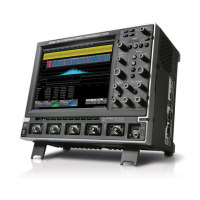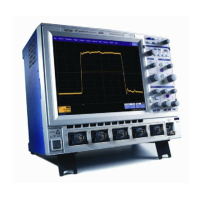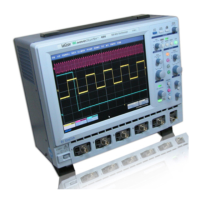X-Stream Operator’s Manual
WM-OM-E Rev I 377
• Adjacent Transitions (d): Corresponds to the "d" in RLL code specified as m/n(d,k) ---
"d" is the minimum number of non-transitions between transitions. If d=0 then adjacent
transitions are allowed. If d=1, then adjacent transitions are not permitted. For E2PR4
this field can also be set to d=2.
• VCO Synch Pattern: In a normally operating disk drive, every time Read Gate goes
true (at the beginning of every segment to be read) there must be a repetitive signal
called the VCO Synch. It is a requirement to adjust the phase of the PLL (phase locked
loop), which generates the sampling clock, and to adjust the AGC (automatic gain
control). Most commonly the VCO Synch is 2T.
• Bit Cell Time: is used as a starting estimate of the VCO Synch signal. If the value is
not known and the VCO Synch field is at the beginning of the area to be analyzed,
selecting Measure Bit Cell Time will determine it automatically.
• Ignore last <n> samples: Specifies the amount of "garbage" data to ignore after the
end of the written data and before Read Gate goes false.
Additionally, the parameters below are useful (but not essential) for Channel Emulation with
reference:
• Read Gate: If the Read Gate signal is connected to a DDA channel and specified, it will
be used to determine the regions of the signal to be analyzed. Since the VCO Synch
field is required for Channel Emulation with Reference and is normally present in the
head signal in every block just after Read Gate goes true, it is recommended that Read
Gate be used. If Read Gate is not present, the entire waveform will be used unless the
Analyze Region cursors are enabled.
• Read Gate Polarity: Typically, Read Gate is a positive true signal. However, there are
drives that use a negative true signal for Read Gate. If Read Gate is enabled, this
setting allows you to select whether "True" is high or low.
• Read Clock: If present, the Read Clock signal is used only to determine where the
"sample time" markers (vertical lines) are drawn.
• Specify Region: As previously described, markers can be used to define a subset of
the head signal for analysis.
• Filter Head Signal: If enabled, an equalization filter is applied to the head signal
before processing and display. This feature should be used if the DDA does not have
access to the drive’s equalized head signal.
After the setup is complete, a reference waveform should be acquired and saved by selecting
Store Reference.
Notes on Using Channel Emulation with Reference
1. Time misalignment between the reference and the current acquisition is made up for based
on end of VCO Synch in the first Read Gate true section. If the reference contains multiple
Read Gate true sections, we assume that their relative timing is approximately the same as
in the current acquisition.
2. It is not possible to compare a reference of one sector to each sector in an acquisition
